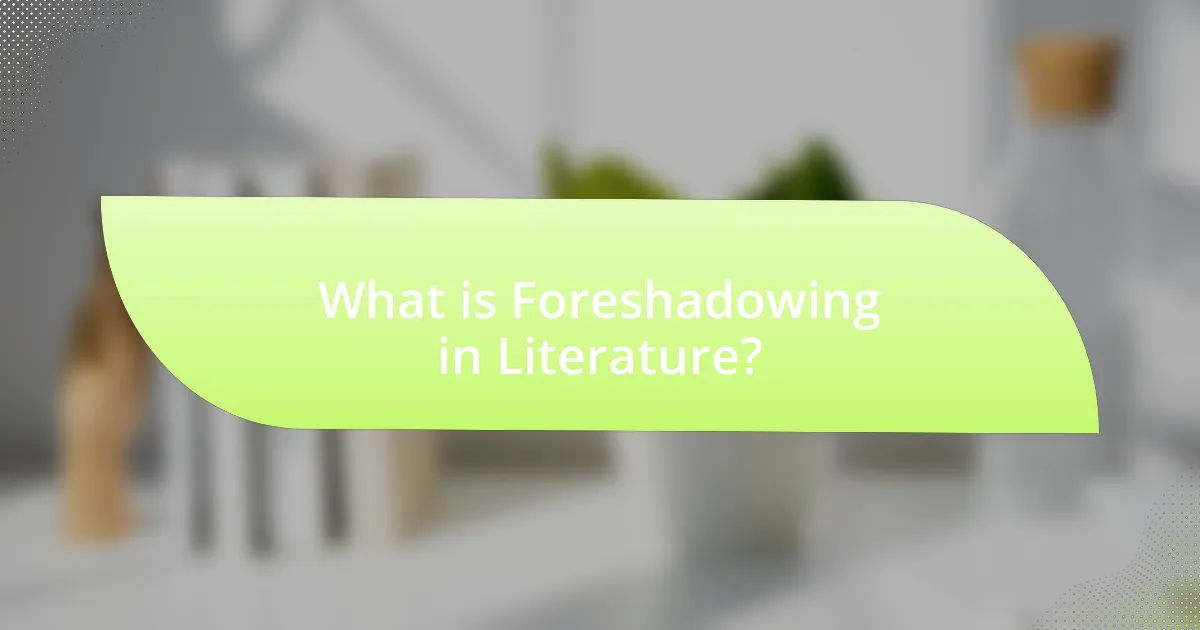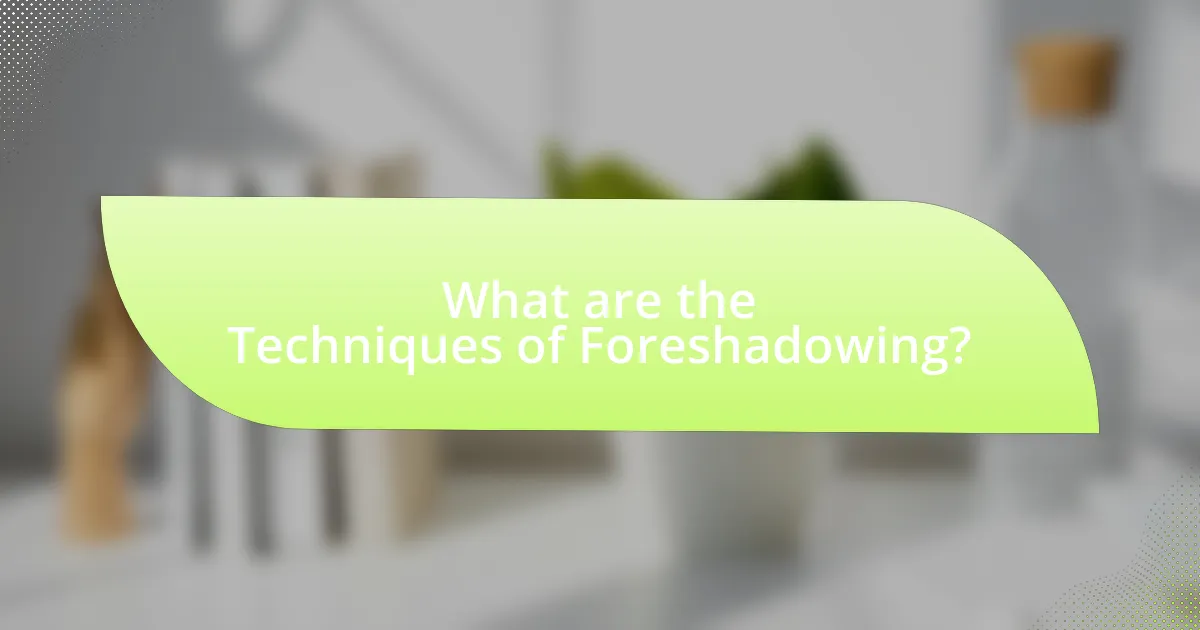Foreshadowing is a narrative technique in literature that provides hints or clues about future events, enhancing suspense and reader engagement. This article explores the significance of foreshadowing in storytelling, detailing its contribution to plot structure, character development, and the creation of anticipation. It categorizes foreshadowing into direct and indirect types, discusses various techniques such as symbolism and dialogue, and highlights best practices for writers to effectively integrate foreshadowing while maintaining surprise. Additionally, the article addresses common pitfalls in analyzing foreshadowing and the impact of context on interpretation.

What is Foreshadowing in Literature?
Foreshadowing in literature is a narrative technique used to provide hints or clues about future events in a story. This technique builds anticipation and suspense, allowing readers to make predictions about the plot’s direction. For example, in Shakespeare’s “Romeo and Juliet,” the prologue foreshadows the tragic fate of the characters, setting the tone for the unfolding drama. This method enhances the reader’s engagement by creating a sense of inevitability and tension, as they become aware of potential outcomes before they occur.
How does foreshadowing contribute to storytelling?
Foreshadowing contributes to storytelling by creating anticipation and building suspense for future events. This literary device subtly hints at outcomes, allowing readers to form expectations and engage more deeply with the narrative. For example, in Shakespeare’s “Romeo and Juliet,” the prologue reveals the tragic fate of the characters, which enhances the emotional impact as the story unfolds. By providing clues about what is to come, foreshadowing enriches the plot and encourages readers to pay closer attention to details, ultimately enhancing their overall experience of the story.
What are the different types of foreshadowing?
There are two main types of foreshadowing: direct foreshadowing and indirect foreshadowing. Direct foreshadowing explicitly hints at future events through clear statements or symbols, allowing readers to anticipate outcomes. For example, in literature, a character’s ominous warning can serve as direct foreshadowing of impending danger. Indirect foreshadowing, on the other hand, subtly suggests future events through context, imagery, or character behavior, requiring readers to infer potential outcomes. An example of indirect foreshadowing is a character’s recurring nightmares that hint at future conflicts or tragedies. Both types effectively build suspense and engage readers by creating expectations about the narrative’s direction.
How does foreshadowing enhance character development?
Foreshadowing enhances character development by providing hints about a character’s future actions or fate, which deepens the audience’s understanding of their motivations and traits. This technique allows readers to anticipate how a character may evolve in response to impending events, thereby creating a more engaging narrative. For instance, in literature, when a character exhibits subtle signs of inner conflict early on, foreshadowing can indicate a significant transformation later, illustrating their growth or decline. This method not only builds suspense but also enriches the character’s arc, making their eventual decisions more impactful and relatable.
Why is foreshadowing important for building suspense?
Foreshadowing is important for building suspense because it creates anticipation and prepares the audience for future events. By subtly hinting at what is to come, foreshadowing engages the audience’s curiosity and heightens their emotional investment in the narrative. For example, in literature and film, early clues about a character’s fate or impending danger can lead viewers to speculate and worry about outcomes, thereby increasing tension. This technique is widely recognized in storytelling, as it effectively maintains interest and keeps the audience on edge, making them eager to see how the foreshadowed events will unfold.
How does foreshadowing create anticipation in readers?
Foreshadowing creates anticipation in readers by providing subtle hints or clues about future events in a narrative. This technique engages readers’ curiosity and prompts them to speculate about potential outcomes, thereby heightening their emotional investment in the story. For example, when an author introduces a seemingly innocuous detail, such as a character’s nervous behavior or an ominous setting, it can signal upcoming conflict or danger. This method effectively builds suspense, as readers become eager to see how these hints will unfold, creating a sense of urgency and excitement.
What role does foreshadowing play in plot structure?
Foreshadowing plays a critical role in plot structure by providing hints or clues about future events, thereby enhancing suspense and engagement. This technique allows authors to create anticipation and prepare readers for upcoming twists or outcomes, which can lead to a more satisfying narrative experience. For example, in literature, foreshadowing can manifest through dialogue, imagery, or symbolic elements that subtly indicate what is to come, effectively guiding the audience’s expectations and emotional responses. This method not only enriches the storytelling but also contributes to thematic depth, as it often reflects the underlying motifs of fate or inevitability within the plot.

What are the Techniques of Foreshadowing?
Foreshadowing techniques include the use of symbolism, dialogue, and imagery to hint at future events in a narrative. Symbolism involves using objects or actions that represent larger ideas, subtly indicating what may come. Dialogue can reveal character intentions or concerns that suggest future conflicts or resolutions. Imagery creates vivid descriptions that evoke emotions or set a tone, often foreshadowing outcomes through the atmosphere it establishes. These techniques effectively build suspense by preparing the audience for what is to come, enhancing the narrative’s depth and engagement.
How can authors effectively use subtle hints?
Authors can effectively use subtle hints by integrating them into the narrative in a way that feels organic and unobtrusive. This technique involves planting clues that foreshadow future events or character developments without drawing overt attention to them. For instance, an author might mention a seemingly trivial detail, such as a character’s unusual habit or a specific object in a scene, which later becomes significant to the plot. Research indicates that subtle hints can enhance reader engagement by creating a sense of anticipation and encouraging deeper analysis of the text. This method aligns with the principles of foreshadowing, where the effectiveness lies in the reader’s gradual realization of the hints’ importance, thereby building suspense throughout the story.
What are examples of subtle foreshadowing techniques?
Subtle foreshadowing techniques include the use of symbolic imagery, character dialogue, and seemingly innocuous details that hint at future events. For instance, a character might casually mention a fear of heights before a pivotal scene involving a cliff, creating an underlying tension. Additionally, an object in the background, such as a broken clock, can symbolize the passage of time and impending doom. These techniques effectively build suspense by planting seeds of anticipation without overtly revealing future plot points.
How does imagery serve as a foreshadowing tool?
Imagery serves as a foreshadowing tool by creating vivid mental pictures that hint at future events or outcomes in a narrative. This technique allows authors to subtly prepare readers for what is to come, often through descriptive language that evokes emotions or sets a particular mood. For example, a stormy sky described early in a story may foreshadow impending conflict or turmoil, effectively signaling to the reader that significant events are on the horizon. Such imagery not only enhances the thematic depth of the narrative but also engages readers by prompting them to make connections between the imagery and the unfolding plot.
What are the more overt methods of foreshadowing?
Overt methods of foreshadowing include direct statements, symbolic imagery, and character dialogue that hints at future events. Direct statements explicitly indicate what may happen later, such as a character predicting an outcome. Symbolic imagery uses objects or events to suggest future developments, like a storm cloud foreshadowing conflict. Character dialogue can reveal intentions or fears that imply future actions, such as a character expressing doubt about a plan. These techniques effectively build suspense by preparing the audience for what is to come.
How do dialogue and character actions foreshadow events?
Dialogue and character actions foreshadow events by subtly hinting at future developments through specific language and behaviors. For instance, a character’s ominous statement or a seemingly trivial action can create an underlying tension that suggests impending conflict or resolution. This technique is often employed in literature and film to build suspense, as it engages the audience’s anticipation and curiosity. A concrete example is in Shakespeare’s “Romeo and Juliet,” where the characters’ discussions of fate and death foreshadow the tragic ending, illustrating how dialogue can serve as a precursor to significant plot points.
What is the impact of symbolic foreshadowing?
Symbolic foreshadowing significantly enhances narrative depth by subtly hinting at future events through symbols. This technique engages the audience, creating anticipation and emotional investment in the storyline. For instance, in literature, a recurring motif, such as a stormy sky, can symbolize impending conflict, thereby preparing readers for dramatic developments. Research indicates that effective foreshadowing can increase reader satisfaction and engagement, as it allows for a richer interpretation of the narrative and encourages active participation in predicting outcomes.

How can Foreshadowing be Analyzed in Texts?
Foreshadowing can be analyzed in texts by identifying hints or clues that suggest future events, thereby enhancing the narrative’s suspense. This analysis involves examining specific language choices, imagery, and plot developments that signal impending outcomes. For instance, in literature, an author may use ominous descriptions or dialogue that subtly indicate a character’s fate, such as a character expressing fear about an upcoming event, which later unfolds as a pivotal moment in the story. Analyzing these elements allows readers to understand how foreshadowing contributes to thematic depth and emotional engagement, as seen in works like Shakespeare’s “Romeo and Juliet,” where early references to fate foreshadow the tragic conclusion.
What are the key elements to look for in foreshadowing?
Key elements to look for in foreshadowing include subtle hints, symbolic imagery, and character dialogue that suggest future events. Subtle hints often manifest as seemingly minor details that gain significance later in the narrative, such as an object or a phrase that recurs. Symbolic imagery can create a mood or theme that aligns with upcoming plot developments, like dark clouds foreshadowing a storm. Character dialogue may contain ominous statements or predictions that indicate potential outcomes, enhancing the suspense. These elements work together to create anticipation and prepare the audience for what is to come, reinforcing the narrative’s tension and depth.
How can context influence the interpretation of foreshadowing?
Context significantly influences the interpretation of foreshadowing by providing the background and circumstances that shape a reader’s understanding of hints or clues within a narrative. For instance, cultural, historical, or situational context can alter how a foreshadowed event is perceived; a seemingly innocuous detail may take on a sinister meaning if the surrounding context suggests danger or betrayal. Research indicates that readers’ prior knowledge and experiences can lead to varied interpretations of the same foreshadowing element, as demonstrated in studies on narrative comprehension, such as those by Miall and Kuiken (1994), which highlight how context shapes reader engagement and meaning-making.
What are common pitfalls in analyzing foreshadowing?
Common pitfalls in analyzing foreshadowing include overinterpretation, where readers assign meaning to vague hints that may not be intentional, and underinterpretation, where significant clues are overlooked. Additionally, readers often confuse foreshadowing with mere coincidence, failing to recognize the author’s deliberate placement of hints. Misreading the context can also lead to incorrect conclusions about the foreshadowed events. These pitfalls can distort the understanding of the narrative’s structure and the author’s intent, ultimately affecting the overall interpretation of the story.
What are some best practices for using foreshadowing in writing?
Best practices for using foreshadowing in writing include planting subtle hints early in the narrative, ensuring they are relevant to the plot, and maintaining consistency in tone and theme. Subtle hints can be achieved through dialogue, imagery, or character actions that suggest future events without revealing them outright. Relevance to the plot ensures that foreshadowing serves a purpose, enhancing the story’s coherence and depth. Consistency in tone and theme helps to create a unified narrative experience, making the foreshadowing feel organic rather than forced. These practices are supported by literary analysis, which shows that effective foreshadowing enhances reader engagement and builds suspense, as seen in works like “The Great Gatsby” by F. Scott Fitzgerald, where early references to the green light foreshadow Gatsby’s unattainable dreams.
How can writers balance foreshadowing with surprise?
Writers can balance foreshadowing with surprise by strategically placing subtle hints that lead to an unexpected outcome. This technique involves providing clues that are not overtly obvious, allowing readers to make connections without fully revealing the plot twist. For instance, in literature, authors like Agatha Christie often use misdirection, where seemingly innocuous details later play a crucial role in the story’s climax, creating a surprise that feels earned rather than arbitrary. This method ensures that while readers are given a sense of direction through foreshadowing, they remain engaged and surprised by the eventual revelation.
What tips can help writers effectively integrate foreshadowing?
Writers can effectively integrate foreshadowing by planting subtle hints early in the narrative that suggest future events. This technique can be achieved through the use of imagery, dialogue, and character actions that allude to upcoming plot developments. For instance, a character’s seemingly innocuous statement about a storm can foreshadow a significant conflict later in the story. Additionally, employing symbols or motifs consistently throughout the narrative can reinforce the foreshadowing, making it more impactful when the predicted events unfold. This method not only builds suspense but also enhances the reader’s engagement by encouraging them to make connections between the hints and the eventual outcomes.
